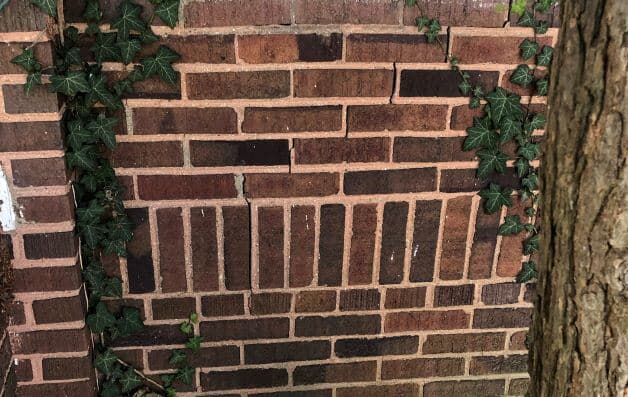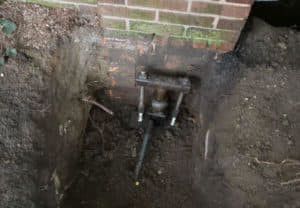
If you’re reading this article, we know a few things about you. For starters, you either own a home or you are interested in buying one. Secondly, the home in question has settling issues with the foundation. And third, you are aware that contractors use piers to repair settling foundations.
Acculevel has been repairing foundations since 1996, and experience has shown us that the best method to fix a settling foundation is by employing helical piers. We warranty our pier installations for the life of your home, to guarantee that they stay in place as installed.
However, there are some drawbacks to using helical piers. Over the years, we’ve encountered three specific issues. In this article, we’re going to explore those issues and walk you through the details. We want all homeowners to be well-informed before making decisions that impact their homes, and believe that honesty and direct communication are in everyone’s best interests.
This video provides a detailed look at the installation process.
This issue only affects about 5% of our customers. But if you’re in that small percentage, it’s going to matter to you because it’s going to cost you extra money.
The standard pier length is 21 feet, and this is enough for most of the homes within our service area. But this may not be long enough to reach the stable and undisturbed soil that piers need to “lock” in place.
If you live in an area with a high water table or the soil composition has a significant amount of organics, the piers may need to be extended to a lower depth. This is an added fee of $20 per foot, multiplied by however many piers are needed.
The worst part of this unexpected cost is that it’s not something we can always know in advance. In specific areas- near bodies of water, for example- we know it’s a possibility. But the only way to know for sure is to install the pier, and read the pressure gauge.
In the event that the standard pier length will not work, the crew or project manager should alert you. This gives you the opportunity to discuss the challenges and added expenses needed to complete the repairs.
[box type="warning"] Please Note: if the piers are not installed the full distance to load-bearing soil, they will be of no benefit to the home. You have the right to choose not to have the additional depth dug. But if you make that choice, your contractor should decline the job. An ethical contractor will not perform or charge you for an installation that will not be up to code.[/box]
Piers need to be dug close to the foundation; they are positioned under your home’s footer. The footer is located at the base of your foundation. Depending on where your foundation needs stabilizing, the piers may need to be installed in an inconvenient location. These are usually places where you’ve built a deck, installed a patio, or established a flower bed.
The least expensive installation method for piers is machine-digging. They can be hand-dug, to minimize damage to the exterior landscape, but manual labor adds to the price and the length of the job. It’s important to note that hand-digging also may not be enough to preserve all of the surrounding area. You may have to relocate plants, remove decking or replace concrete walkways or patio sections.
Unlike the added depth charges, these are expenses that you will know about ahead of time. The project manager that evaluates your foundation should determine the best locations for the piers at the time of the estimate. These locations should be clearly indicated to you before you sign a contract or make a decision. This will allow you time to make plans or arrangements for additional work. These arrangements may be unavoidable, but they increase the time and money you will spend on the repairs.
The pier is driven into the ground outside the foundation until the proper torque is reached.
Then the pier is attached to the foundation with a bracket under the footing.
 This picture was taken by an Acculevel crew member during installation.
This picture was taken by an Acculevel crew member during installation.
Obviously, having piers installed is going to interrupt your daily routine. There will be digging and drilling done around the foundation of your home. There will be noise from the machines that is loud enough to be an irritation, but not enough to pose any threats to your well-being. If the piers are required to be installed inside your garage or basement, you will notice some dust from the work also.
At Acculevel, we call 811 and request any utility locates that need to be done before installations. This may not be true for all contractors, so we recommend that you confirm which party is responsible for this. It is essential that utility companies have their buried lines marked in advance of any digging at your home.
Despite everyone’s best efforts, sometimes these locate requests are not done thoroughly, or they omit a service. When digging begins, contractors and crew members all they can to avoid any overlooked or unmarked utility lines. But accidents do happen, and sometimes you may lose a service (most commonly cable or internet) temporarily. This is an inconvenience at best, but if you work from home, you may have lost productivity as a result.
We’ve documented the disadvantages and inconveniences related to pier installation in this article. But we want to remind you that after more than two decades in this business, we maintain that helical piers are the most efficient, cost-effective and permanent solution for settling foundations.
If you would like more information about helical piers, we have an article that details how they work and what they cost. If you are curious about the alternative option of push piers, we compare the two methods in another post.
If you’re unsure if helical piers or foundation repair is needed, but know something isn’t right, we’ve created a symptom checker for you. This is a great tool if you know the symptoms in your home, like cracked foundation walls or sagging floors, and need to know your repair options. We also have a comprehensive guide to foundation repairs that reviews everything from crack assessment to pier installation.
If you think helical piers may be needed, follow these steps. Find an experienced local foundation company, and make an appointment. Before you sign a contract for any service, you should always verify the company is reputable, insured, and accredited by the Better Business Bureau.
If you live in Indiana or the surrounding states, Acculevel specializes in helical pier installation. If you have noticed any of the warning signs in your home, we always welcome you to request a free estimate. Our experienced project managers will evaluate your foundation condition and recommend the best course of action for you, to keep your home strong and healthy for years to come.
A settling foundation will reduce your home’s value and make it difficult to insure or sell. If you don’t repair the foundation, the structural damage will spread throughout the home- a ripple effect that leads to broken pipes, doors and windows that won’t open/close, and sloping floors. If you think your foundation may be settling, take action today before this leads to other problems.
[DISPLAY_ULTIMATE_SOCIAL_ICONS]